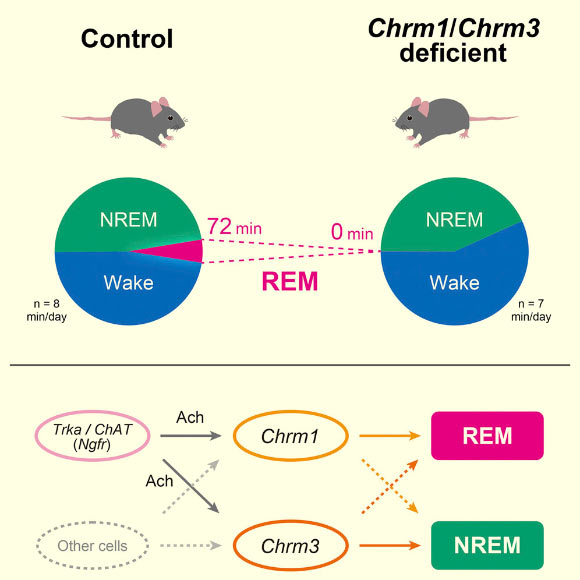An international group of scientists from Japan and Australia has identified two essential genes involved in the regulation of rapid eye movement (REM) sleep.

The acetylcholine pathway has been proposed to be important for wakefulness and REM sleep, but genetic evidence has been missing. Using a knockout of acetylcholine receptor genes, Niwa et al show that Chrm1 and Chrm3 double knockout chronically diminishes REM sleep to an undetectable level and causes a severe short-sleep phenotype. Image credit: Niwa et al, doi: 10.1016/j.celrep.2018.07.082.
“Sleep is a universal and vital behavior in animals. In higher vertebrates such as mammals and birds, sleep is classified into two phases, REM sleep and non-REM sleep,” said Dr. Hiroki Ueda of the RIKEN Center for Biosystems Dynamics Research and the University of Tokyo and colleagues.
“During REM sleep, our brain is as active as it is during wakefulness, and this stage is believed to function in memory consolidation.”
In the new study on mice, Dr. Ueda’s team found that two acetylcholine receptor genes — Chrm1 and Chrm3 (cholinergic receptor muscarinic 1 and 3) — are essential for REM sleep.
“The neurotransmitter acetylcholine and its receptor are important for the regulation of REM sleep. Acetylcholine is abundantly released in some parts of mammalian brain during REM sleep and wakefulness,” they said.
“However, it was unclear which receptor or receptors were directly involved in the regulation of REM sleep due to the complexity of the underlying neural network.”
The researchers found that the loss of Chrm1 and Chrm3 receptors induced a characteristic short-sleep profile. These two receptors are widely distributed in distinct brain regions.
The knockout of Chrm1 reduced and fragmented REM sleep, whereas knocking out Chrm3 reduced the length of non-REM sleep.
When both genes were knocked out, mice failed almost entirely to experience REM sleep, but survived nonetheless.
“The surprising finding that mice are viable despite the almost complete loss of REM sleep will allow us to rigorously verify whether REM sleep plays a crucial role in fundamental biological functions such as learning and memory,” said study first author Dr. Yasutaka Niwa, from the RIKEN Center for Biosystems Dynamics Research and the University of Tsukuba.
“The discovery that Chrm1 and Chrm3 play a key role in REM sleep opens the way to studying its underlying cellular and molecular mechanisms and will eventually allow us to define the state of REM sleep, which has been paradoxical and mysterious since its original report,” Dr. Ueda said.
The findings were published in the August 28, 2018 issue of the journal Cell Reports.
_____
Yasutaka Niwa et al. 2018. Muscarinic Acetylcholine Receptors Chrm1 and Chrm3 are Essential for REM Sleep. Cell Reports 24 (9): 2231-2247; doi: 10.1016/j.celrep.2018.07.082







